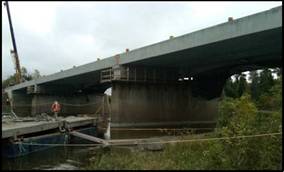Executive Summary: Completed North American Ductal® Bridges

October, 2009
|
The Sherbrooke Pedestrian Bridge, Quebec (1997) is the first Ductal® bridge world-wide, spanning 60m with a space truss, 6 precast segments (10 m long x 3 m high) and a top deck just 30 mm thick. With no passive reinforcement, this revolutionary bridge provided important validation of Ductal® as a superior, "ultra-high performance concrete" material and opened the door to innovative new possibilities in the world of bridge design and construction. This project won a Precast/Prestressed Concrete Institute (PCI) Design Award. |

|
 |
*The Federal Highway Administration (FHWA), Virginia installed a Ductal® pi-girder for long-term and destructive testing at their laboratory in Virginia in 2003. The girder includes a deck without rebar (corroding rebar is a major problem with thousands of existing bridges). FHWA's ongoing R&D demonstrates the use of Ductal® for bridges, generates comparative case studies, validates designs without rebar and gives confidence to transportation engineers. To date, numerous related papers have been published by FHWA including (in 2006): "Material Property Characterization of Ultra-High Performance Concrete" and "Structural Behaviour of Ultra-High Performance Concrete Prestressed I-Girders". |
|
*The Wapello/Mars Hill Bridge, Iowa (2005) is the first North American Ductal® highway bridge; a collaboration involving the FHWA, Iowa DOT, ISU and Lafarge. It is a simple, single-span with a 3-beam cross section and three 33.5 m Ductal® girders without rebar for shear stirrups. This project won a Portland Cement Association (PCA) Concrete Bridge Award. |
 |
 |
The Rainy Lake Bridge, Ontario (2006) is the world's first Ductal® Joint Fill ("JS1000") project; part of an innovative field cast joint solution for a bridge superstructure/precast deck panel system specially developed for the Ministry of Transportation of Ontario. Through its design, testing and construction, this project validated a precast bridge deck with a 200 mm wide joint (conventional design is 600 mm wide) and led the way to other, repetitive joint fill projects. |
 |
*The Glenmore Trail/Legsby Pedestrian Bridge, Alberta (2007) is a single span, 53 m bridge that crosses 8 lanes of traffic, consisting of 2 cantilevered, high performance concrete abutments and a 33.6 m drop-in, T-section Ductal® girder. The girder required 40 m3 of material and the largest, single monolithic pour of Ductal® in the world to date. This project won a Precast/Prestressed Concrete Institute (PCI) Special Jury Award for Innovative Technology and 2 American Concrete Institute (ACI) Awards of Excellence in Concrete. |
 |
The Current River Bridge, Ontario (2007) utilized Ductal® Joint Fill for precast curb sections under bridge railings. |
|
The Sunshine Creek Bridge, Ontario (2007) is a single span, box girder bridge with Ductal® Joint Fill along the length of the girders. It is built with 10 box girders (600 mm thick) side-by-side and 9 Ductal® joints. Ductal® was also used in the approach slabs and curbs.
|

|
 |
Hawk Lake Bridge, Ontario (2008) is another successful Ductal® Joint Fill project with an advanced precast bridge deck system. Advantages and benefits include: simplified fabrication and installation processes, superior freeze/ thaw resistance, extremely low porosity, improved flexural strength, superior toughness with resistance to harsh climates and continuous flexing from truck loadings across the joints. |
|
*The Jakway Park Bridge, Iowa (2008) is North America's first highway bridge built with a new generation of three Ductal® pi-girders; the first North American highway bridge to incorporate batching of Ductal® in a ready-mix truck and; the second highway bridge in Iowa and North America with Ductal® girders. This project won an Iowa Quality Initiative Structures Research Merit Award and a Precast/ Prestressed Concrete Institute (PCI) Design Award. |
 |
 |
*The Country Hills Pedestrian Bridge, Alberta (2008) has a 33.5 m Ductal® drop-in girder. This 49 m clear span bridge crosses over 6 lanes of traffic, providing the two adjacent communities with an aesthetically pleasing, durable curved-linear link. This is the first pedestrian bridge project where Ductal® was batched in a ready mix truck. |
|
The Cat Point Creek Bridge, Virginia (2008) has five, 24.3 m Ductal® bulb-tee girders and a conventional cast-in-place deck; another excellent example of Ductal's ability to create longer, thinner bridge girders with reduced weight and improved durability. |
 |
 |
The Village of Lyons Bridge, New York (2009) is a side by side, single Bulb-Tee girder project. The photo (left) is a close-up of the finished joint, showing the surface aspect and quality of the joint. The bridge consists of 8 – 26 meter long, side by side Single Bulb-Tee Girders with Ductal® JS1000 Joint Fill. |
|
Oneonta, New York (2009) is built with 22 precast slabs jointed on top of 5 steel girders (slab thickness: 200 mm).
|

|
The following bridges, "Buller Creek" and "Log River", were completed for the Ministry of Transportation of Ontario (MTO) in 2009. Each bridge is constructed with precast concrete and joined together with Ductal® Joint Fill --resulting in extremely durable, advanced bridge deck systems that will last, through harsh climates and heavy traffic loads for many decades ahead.
 |
Buller Creek
|
|
Log River
|
 |
|
The Eagle River Bridge is another Ductal® Joint Fill project currently underway for the MTO. It will be the first multiple span box girder bridge using Ductal® Joint Fill. Phase 1 has been completed. It has 36 box girders (12 side-by-side over 3 spans) requiring 33 Ductal® joints to join the girders together and 3 Ductal® joints joining the spans together. Ductal® will also be used in the approach slabs and the curbs.
|

|
To date, North American Ductal® bridge projects have won 6 awards, thereby strengthening Lafarge's position as the leader in ultra-high performance concretes.
*Precast Ductal elements were produced by Lafarge Precast (Winnipeg and Calgary).
For additional information, please contact:
Lisa Birnie, Marketing/Communications Manager – Ductal®, Lafarge North America Phone: 403-292-9246 or email: lisa.birnie@lafarge-na.com
LAFARGE CANADA INC. 10655 Southport Road, SW, Suite 1200 Calgary, Alberta T2W 4Y1 Phone: 1-866-238-2825 or (403)271-9110 Fax: (403)278-7420 Email: ductal@lafarge-na.com www.imagineductal.com

